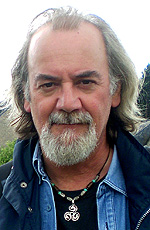About

Renato Ghisetti, “René”, was born in Torino, Italy, in 1953. At the age of six his family moved to South Africa where he grew up and lived until the age of twenty-nine. In 1982 he returned to Italy and settled in his native town, Torino. Today he lives and works in Fiano, a small village near Torino.
Renato started painting while still at school, devoting himself firstly to op-art and then to psychedelic art, in which he was able to find an outlet for his great passion for colour. In 1972, having completed his studies, he attended the Johannesburg College of Art for a year. The following year he abandoned College and started working as a potter in a ceramics factory, with painting limited to his free time.
In 1979 he moved to the beautiful woodland area of Sabie, in the eastern part of the country, devoting himself exclusively to painting. In the solitude of the woods the artist developed his painting into a form of geometrical symmetry, greatly influenced by the 'mandala' of the East, tantric yoga and the phantasmagorical forms of the kaleidoscope. In 1980 he held his first exhibition at the Trevor Coleman Gallery in Johannesburg.
Still in 1980, Renato moved for a short period to Capetown, the centre of South African cultural activity. His stay in that city brought about a further change in his painting. From the geometrical he passed to a very personal style, more fluid and almost figurative, a style, as Giancarlo Barsotti writes, "... with almost defined forms that emerge from lines, curves and spirals that are soaked in colour, at times dramatic and violent and at times soft and delicate." Renato presented these new works to the public in his second exhibition, again held in Johannesburg, at Laura's Laden Gallery, in 1982. In this exhibition, he was presented as " a serious, tenacious artist, dramatic and poetic in inspiration, and with a solid artistic preparation of his own; his imagination and fantasy and brush succeed in measuring and amalgamating colours and movement, achieving dramatic, at times hallucinary effects and creating forms, or quasi-forms, that seem as though they are struggling to emerge from the canvas.
After this second exhibition, the artist decided to return to and settle in Italy in his native city where yet another change takes place. "In Torino", writes Antonio Oberti, "Renato Ghisetti discovered differing possibilities, new connections and felicitous intuitions within himself. His view of reality, in penetrating and existential visual terms, gives increasing prominence to the human figure: an articulated chromatic modulation which, involving emotive and psychological impulses, immerses this reality into a universal world of dream." What strongly emerges from the artist's work is the message, the intrinsic content, the wish to communicate, that moves the soul with immediacy. It is therefore not this or that iconic theme which counts, but the expressive force with which the artist communicates with his public, speaking a language that is both universal and ancient.
